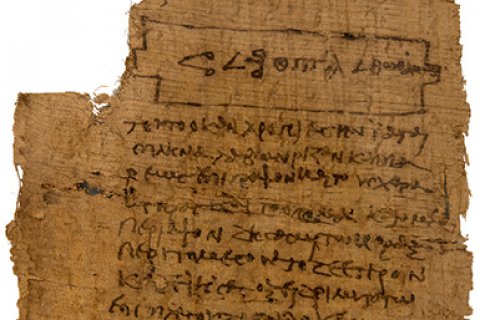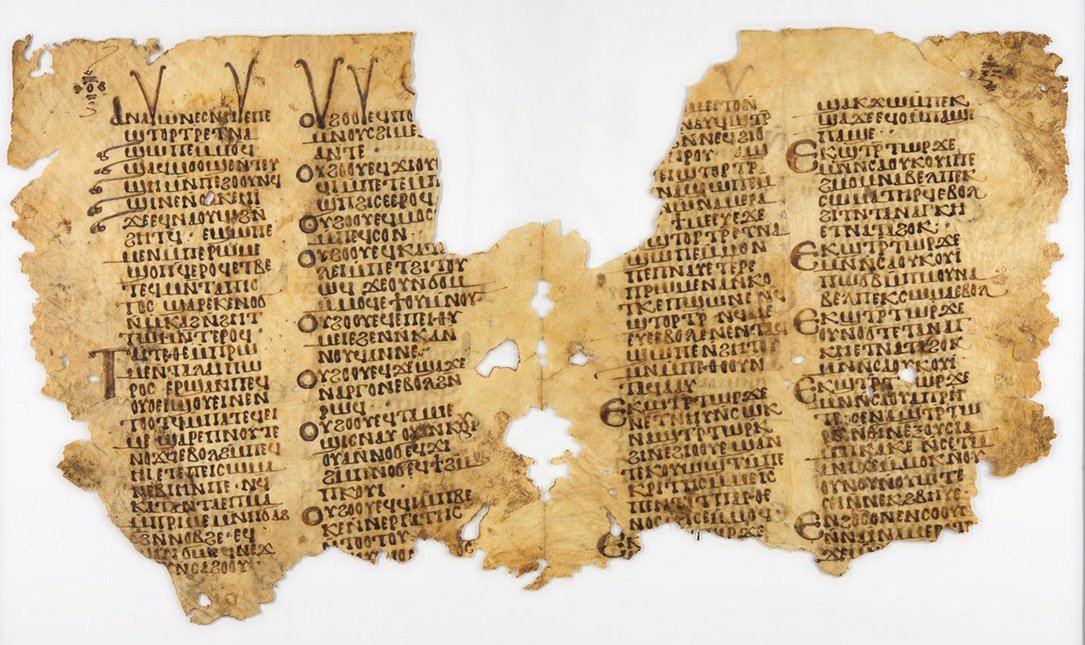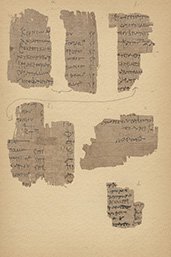Collection of Coptic manuscripts
The collection of Coptic manuscripts in Utrecht University Library

Berlin, Heidelberg, Copenhagen, Lund, Oslo, Princeton, Utrecht: these cities all have in common that their university libraries possess papyri or other objects which used to belong to the German coptologist Carl Schmidt (1868-1938). In 1956, as the last one in line, Utrecht acquired some special papyri and parchment manuscripts, a few containing unique texts.
Bargaining over papyri in 1944

These Coptic manuscripts were not the first to be included in the collection of the University Library. In October 1944 while the Allied liberated the Dutch provinces of Zeeland and Noord-Brabant, librarian Abraham Hulshof closed a deal with bookseller Ernst Fischer (1866-1951) from Freiburg im Breisgau. For 1,700 Dutch guilders he obtained fifteen fragments of Greek and Demotic papyri from a mummy cartonnage and a Coptic fragment about merchandise, and some medieval manuscripts, including one from Melk Abbey in Austria (now Ms. 10 B 1).
Although there are some unexplained details, the papyri were probably unearthed by Egyptologist Augustus Eisenlohr (1832-1902), later professor in Heidelberg. His widow sold them to Fischer in 1909, at the time living in Weinberg near Heidelberg, through the agency of G. Korn from Ludwigshafen. The fragments are now catalogued as Ms. 10 D 1.

The acquisition of the Schmidt collection
The collection of papyri and parchment manuscripts which had once belonged to Carl Schmidt was of greater importance however. This collection was acquired for the University Library by Prof. Gilles Quispel (1916-2006) in 1956. He bought it from Schmidt’s niece, G. Kunta-Schmidt. Previously, Quispel had received the microfilm of a part of the fragments and discussed them with Paul E. Kahle Jr. (1923-1955). The latter was particularly enthusiastic about the dozens of Coptic fragments; the Demotic and Greek fragments he considered to be of less value. Still, Utrecht University decided to buy the entire Schmidt collection, and the most important pieces were exhibited in the Theological Institute in 1956. For this occasion they were mounted under glass, and given the numbers 1 to 14. This was not always done with the greatest accuracy: in some cases the number was put on the verso side. Six other pieces were also mounted under glass, but remained unnumbered, probably because they were not part of the exhibition. In the following years research was done on the fragments by Quispel, Jan Zandee (1914-1991) and Roelof van den Broek (1931-). The fragments are roughly dated between 200 and 800; where and how Schmidt obtained them is still a mystery.
Missing sheets

The fragments of the apocryphal ‘Acts of Andrew’ were considered the most important, but also the fragments of ‘The Life of Eupraxia’, ‘The Martyrdom of Saint Pantaleon’ and a part of the homily ‘On the Virgin Mary’ were published. Sheets of the latter text and some others, including the ‘Second Eulogy on the life of Claudius of Antioch’, turned out to have been offered for sale to the University of Michigan in Ann Arbor as early as 1930. The university decided against the acquisition, but the photographs were kept of which one is of a sheet missing in the Utrecht collection. It is unknown if this sheet is somewhere else or has been lost.
Cataloguing
In 2017 Roelof van den Broek completed his Catalogue of the Coptic manuscripts in the Utrecht University Library (pdf, 2017), which contains an extensive discussion on the provenance of the fragments as well as transcriptions of the fragments which had not been published before. In most cases the fragments are from the Bible, in particular the Psalms which include fragments of a Lycopolitan Psalter. He published a separate article on a Greek-Coptic magical papyrus.
Digitisation
![Koptische collectie-[79] Gebed](/sites/default/files/styles/image_171x257/public/UBBC-Handschriften-Koptische%20collectie-%5B79%5D%20Gebed-200x507.jpg?mt=1594650078&itok=T2cS---3)
In 2017, the Coptic fragments of the Schmidt collection were digitised, and also Ms. 10 D 1. Immediately after the acquisition these fragments were kept apart in boxes 1 to 5, while the Greek and Demotic fragments were all put in box 6. Below you will find an overview of the Coptic fragments from the boxes 1-5 (B1-B5; the B is for Box), the catalogue numbers in parenthesis and the page number in the digital presentation between square brackets.

![Koptisch manuscript, [01] Over de maagd Maria](/sites/default/files/styles/image_1600x300/public/UBBC-Handschriften-Koptische%20collectie-Coptic%20B1.1%20Pseudo-Theophilus%20of%20Alexandria%2C%20On%20the%20Virgin%20Mary%20-banner-1600x300.jpg?itok=dFKB9-Zh)